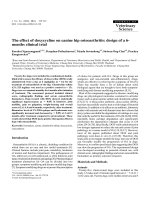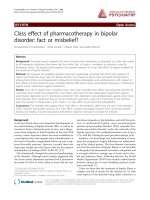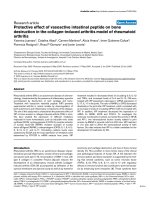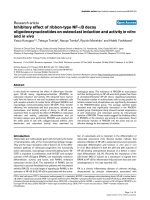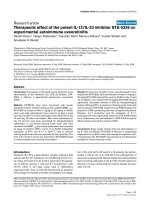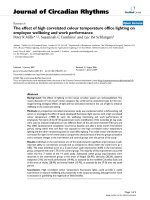Báo cáo y học: "Early effect of a single intravenous injection of ethanol on hepatic sinusoidal endothelial fenestrae in rabbits" pdf
Bạn đang xem bản rút gọn của tài liệu. Xem và tải ngay bản đầy đủ của tài liệu tại đây (337.49 KB, 5 trang )
BioMed Central
Page 1 of 5
(page number not for citation purposes)
Comparative Hepatology
Open Access
Research
Early effect of a single intravenous injection of ethanol on hepatic
sinusoidal endothelial fenestrae in rabbits
Frank Jacobs
1
, Eddie Wisse
2,3
and Bart De Geest*
1
Address:
1
Center for Molecular and Vascular Biology, Department of Molecular and Cellular Medicine, University of Leuven, Herestraat 49,
Leuven, 3000, Belgium,
2
EM Unit Pathology Department, University of Maastricht, Universiteitssingel 50, Maastricht, 6229-ER, the Netherlands
and
3
Department of Internal Medicine, University of Maastricht, Universiteitssingel 50, Maastricht, 6229-ER, the Netherlands
Email: Frank Jacobs - ; Eddie Wisse - ; Bart De Geest* -
* Corresponding author
Abstract
Background: It has been postulated that ethanol affects hepatic sinusoidal and perisinusoidal cells.
In the current experimental study, we investigated the early effect of a single intravenous dose of
ethanol on the diameter of liver sinusoidal endothelial fenestrae in New Zealand White rabbits. The
diameter of fenestrae in these rabbits is similar to the diameter found in humans with healthy livers.
The effect of ethanol on the size of fenestrae was studied using transmission electron microscopy,
because plastic embedding provides true measures for the diameter of fenestrae.
Results: After intravenous administration of a single dose of 0.75 g/kg, ethanol concentration
peaked at 1.1 ± 0.10 g/l at ten minutes after injection. Compared to control rabbits (103 ± 1.1 nm;
n = 8), the average diameter of fenestrae in ethanol-injected rabbits determined at 10 minutes after
injection was significantly (p < 0.01) smaller (96 ± 2.2 nm; n = 5). Detailed analysis of distribution
histograms of the diameters of fenestrae showed that the effect of ethanol was highly
homogeneous.
Conclusion: A decrease of the diameter of fenestrae 10 minutes after ethanol administration is
likely the earliest morphological alteration induced by ethanol in the liver and underscores the
potential role of liver sinusoidal endothelial cells in alcoholic liver injury.
Background
It has been postulated that ethanol primarily targets
hepatic sinusoidal and perisinusoidal cells [1]. In experi-
mental models and in human studies, plasma hyaluronic
acid levels are elevated in alcoholic liver injury, which
may reflect a diminished hepatic clearance by liver sinu-
soidal endothelial cells [2-4]. Chronic ethanol exposure
leads to defenestration in liver sinusoidal endothelial cells
which is paralleled by the deposition of a basal lamina
[5]. Subsequently, capillarization of hepatic sinusoids fur-
ther impairs microcirculatory exchange of nutrients and
the clearance of waste products, enhances tissue fibrosis,
and will affect the hepatic parenchyma and its metabo-
lism. Whereas this sequence of events has been corrobo-
rated by several studies, it is not well established to which
extent a single administration of ethanol affects liver sinu-
soidal endothelial cells. Previous studies have shown that
ethanol slightly (6%) increases the diameter of fenestrae
in liver sinusoidal endothelial cells in vitro [6,7]. In con-
trast, scanning electron microscopy studies in vivo showed
significant decreases of the diameter of sinusoidal
endothelial fenestrae [8], suggesting that the transport of
plasma substances from sinusoids to parenchymal liver
cells may already be impaired by acute ethanol intake.
Published: 13 July 2009
Comparative Hepatology 2009, 8:4 doi:10.1186/1476-5926-8-4
Received: 25 March 2009
Accepted: 13 July 2009
This article is available from: />© 2009 Jacobs et al; licensee BioMed Central Ltd.
This is an Open Access article distributed under the terms of the Creative Commons Attribution License ( />),
which permits unrestricted use, distribution, and reproduction in any medium, provided the original work is properly cited.
Comparative Hepatology 2009, 8:4 />Page 2 of 5
(page number not for citation purposes)
Because scanning electron microscopy is applied on dried
and thus shrunken specimens, lege artis determination of
the diameter of fenestrae requires transmission electron
microscopy of plastic-embedded specimens. Quantifica-
tion of the diameters in these sections is performed on
fenestrae that become visible as holes when the sinusoidal
wall is cut tangentially. The goal of the current investiga-
tion was to establish unambiguously whether a single
intravenous injection of ethanol administration has an
effect on the diameter of fenestrae in vivo. We have
recently shown that the diameter of fenestrae in human
healthy livers, fixed by injecting glutaraldehyde into fresh
wedge biopsies, is similar compared to fenestrae in the liv-
ers of New Zealand White rabbits [9] and is significantly
smaller than in mice [10] or rats [11]. Therefore, diame-
ters were determined using transmission electron micros-
copy ten minutes after injection of ethanol or 0.9% NaCl
in New Zealand White rabbits.
Results
A dose of 0.75 g/kg ethanol was administered intrave-
nously via a marginal ear vein to male New Zealand White
rabbits. The ethanol concentration in plasma is shown in
Figure 1. Ethanol concentration peaked at 1.1 ± 0.10 g/l (n
= 5) at 10 minutes and was 0.35 ± 0.041 g/l (n = 5) at 2
hours after injection. Ethanol was below detection limit
(0.06 g/l) at 4 hours after injection. The time-point corre-
sponding to the peak ethanol concentration (10 minutes
after injection) was chosen to determine the diameter of
fenestrae by transmission electron microscopy.
A representative transmission electron micrograph used to
measure the diameter of fenestrae in male New Zealand
White rabbits is shown in Figure 2. The average number of
measurements per liver was 640 ± 98 (n = 8) and 690 ± 67
(n = 5) in 0.9% NaCl and ethanol-injected rabbits, respec-
tively. The frequency distribution histogram of diameters
of liver sinusoidal fenestrae determined by transmission
electron microscopy 10 minutes after injection of 0.9%
NaCl or ethanol is provided in Figure 3. Compared to
control rabbits (103 ± 1.1 nm), the average diameter of
fenestrae in ethanol-injected rabbits was significantly
smaller (96 ± 2.2 nm; p < 0.01). The effect of ethanol on
the diameter of fenestrae was homogeneous (Figure 3) as
evidenced by significant reductions of the percentile 10
(72 ± 1.7 nm versus 79 ± 1.1 nm; p < 0.01), percentile 25
(82 ± 1.7 nm versus 89 ± 1.3 nm; p < 0.05), median (94 ±
1.8 nm versus 100 ± 1.3 nm; p < 0.05), percentile 75 (107
± 2.3 nm versus 113 ± 1.4 nm; p < 0.05) and percentile 90
values (122 ± 3.2 nm versus 130 ± 1.4; p < 0.05 nm) in eth-
anol-treated rabbits compared to control rabbits.
Discussion
The current study, using lege artis transmission electron
microscopy measurements, shows that ethanol at toxico-
Plasma ethanol concentrations in New Zealand White rab-bitsFigure 1
Plasma ethanol concentrations in New Zealand
White rabbits. Ethanol concentration (g/l) in New Zealand
White rabbits injected with 0.75 g/kg ethanol. Data are
expressed as means ± SEM (n = 5).
Transmission electron micrograph of liver sinusoidal endothelial fenestrae in New Zealand White rabbitsFigure 2
Transmission electron micrograph of liver sinusoidal
endothelial fenestrae in New Zealand White rabbits.
The endothelial lining is cut tangentially and shows the occur-
rence of fenestrae (f) mostly in groups, called sieve plates. To
the left and the right hand side of the picture, we find the
space of Disse (Sd) with sparse microvilli (mv) protruding
from parenchymal cells. The right top corner of the picture
shows the lumen (L) of the sinusoid. The right bottom part
of the picture shows the cytoplasm of a parenchymal cell.
Comparative Hepatology 2009, 8:4 />Page 3 of 5
(page number not for citation purposes)
logically relevant levels significantly decreases the diame-
ter of fenestrae in New Zealand White rabbits. Since this
effect was observed ten minutes after ethanol injection,
this study is in line with the view that the liver sinusoidal
endothelial cells are the first hepatic cells that undergo
morphological changes in alcoholemia [1].
Both endothelin-1 and NO may play a role in the effect of
ethanol on the diameter of fenestrae. Previously, it has
been demonstrated that ethanol induces hepatic vasocon-
striction in isolated perfused rat liver and that endothelin-
1 antibodies significantly inhibit this ethanol-induced
hepatic vasoconstriction [12]. Since endothelin-1 has
been shown to induce contraction of hepatic sinusoidal
endothelial fenestrae [13], endothelin-1 may mediate the
decrease of the diameter of fenestrae after ethanol injec-
tion. Although hepatic vasoconstriction in isolated per-
fused rat liver persists during ethanol exposure, portal
pressure gradually decreases [12]. This attenuation of eth-
anol induced vasoconstriction is mediated by NO[12].
Similarly, NO may oppose the contraction of hepatic
sinusoidal endothelial fenestrae by endothelin-1: it
induces a decrease in the cytosolic free calcium concentra-
tion leading to the dissociation of calcium and calmodu-
lin from the myosin light chain kinase. Under these
conditions, myosin light chain phosphatase dephosphor-
ylates the myosin light chain and causes relaxation of
fenestrae [14]. NO bioavailability in the sinusoid in the
presence of ethanol will depend on two opposing factors.
On the one hand, ethanol increases both endothelial NOS
(eNOS) expression and NO production [15]. On the other
hand, ethanol has also been shown to induce a release of
superoxide anions into the hepatic sinusoid [16,17],
reducing NO bioavailability. The source of superoxide
may be the liver sinusoidal endothelial cells [16] them-
selves as well as Kupffer cells [17]. Differences in endothe-
lin-1 production and NO bioavailability between the in
vitro setting and in vivo experiments may explain the dis-
crepant results between different studies [6-8]. Whereas
previous in vitro studies [6,7] have shown that ethanol
slightly increases the diameter of fenestrae in liver sinusoi-
dal endothelial cells, an in vivo scanning electron micros-
copy study in rats showed significant decreases in the
diameter of sinusoidal endothelial fenestrae [8], similar as
in the current study.
Previously, it has been shown that acute ethanol adminis-
tration in Balb/c mice increased hyaluronic acid levels, a
functional marker for sinusoidal endothelial liver cells, at
3 hours and 6 hours, whereas alanine aminotransferase
levels, a marker of hepatocyte damage, were unchanged
[4]. In the current study, a decrease of the diameter of
fenestrae was observed as early as 10 minutes after injec-
tion. This may be the first effect of ethanol on liver sinu-
soidal endothelial cells and the earliest morphological
alteration induced by ethanol in the liver. The smaller
diameter of sinusoidal endothelial fenestrae following
acute ethanol intake may induce a decrease of microcircu-
latory exchanges between the sinusoidal lumen and the
space of Disse. This may contribute to protection of paren-
chymal liver cells from the toxic effects of ethanol.
Conclusion
The current study, showing a reduced diameter of
fenestrae within 10 minutes following a single intrave-
nous ethanol administration, underscores the potential
role of liver sinusoidal endothelial cells in alcoholic liver
injury. The reduction in the diameter of sinusoidal
fenestrae may reduce the exchange between the sinusoidal
lumen and the space of Disse and may therefore contrib-
ute to protecting parenchymal liver cells from the toxic
effects of ethanol.
Methods
Animal experiments
All experimental procedures in animals were performed in
accordance with protocols approved by the Institutional
Animal Care and Research Advisory Committee. The
investigation conforms with the Guide for the Care and Use
of Laboratory Animals published by the US National Insti-
tutes of Health (NIH Publication No. 85-23, revised
1996). New Zealand White rabbits were obtained from
the University of Gent (Merelbeke, Belgium). Experiments
were performed at the age of 4 months.
Frequency distribution histograms of the diameter of liver sinusoidal endothelial fenestrae in New Zealand White rab-bitsFigure 3
Frequency distribution histograms of the diameter of
liver sinusoidal endothelial fenestrae in New Zealand
White rabbits. Comparison of the frequency distribution
histograms of the size of sinusoidal fenestrae in New Zealand
White control rabbits (black bars; n = 8) and New Zealand
White rabbits injected with 0.75 g/kg ethanol 10 minutes
before perfusion fixation (white bars; n = 5). Each bar corre-
sponds to a 5 nm interval.
Comparative Hepatology 2009, 8:4 />Page 4 of 5
(page number not for citation purposes)
Study design
A dose of 0.75 g/kg ethanol was administered intrave-
nously via a marginal ear vein to male New Zealand White
rabbits (n = 5) at the age of 3 months and blood sampling
was performed at 0 minutes, 10 minutes, 30 minutes, 2
hours and 4 hours. In separate experiments, male New
Zealand White rabbits were intravenously injected with
0.9% NaCl (n = 8) or 0.75 g/kg ethanol (n = 5) 10 minutes
before perfusion fixation of the rabbit liver. The average
weight of rabbits in these experiments was 2.9 ± 0.25 kg
(n = 18) and was not significantly different between dif-
ferent groups.
Blood sampling
Blood was obtained from the central ear artery and antico-
agulated with 1/10 volume of trisodium citrate. Samples
were taken after an overnight fast.
Determination of ethanol concentrations in plasma
Plasma ethanol concentrations were measured using the
alcohol dehydrogenase assay-based ethyl alcohol Flex™
reagent cartridge (Dade Behring Inc., Newark, DE, U.S.A.)
on a Dade Behring Dimension
®
automated clinical chem-
istry analyzer (Dade Behring Inc.).
Quantification of the size of sinusoidal fenestrae by
transmission electron microscopy
Perfusion of the rabbit liver with a fixative solution was
performed essentially as described before [18-20]. After
isoflurane anesthesia and exposure of the liver by laparot-
omy, the hepatic artery and common bile duct were
clamped and two ligatures were placed around the portal
vein. A sharpened 14-gauge pipette was introduced in the
portal vein and fixed by tightening the two ligatures. Per-
fusion fixation was performed at a pressure of 15 cm H
2
O
with 250 to 300 ml of 1.5% glutaraldehyde fixative buff-
ered in 0.067 M cacodylate at pH 7.4. The inferior caval
vein was transsected at the start of the perfusion. The per-
fusion was continued until the colour of the liver changed
from dark reddish brown to yellow brown and the con-
sistency from soft to stiff (equivalent to the stiffness of a
hard boiled egg). The liver was removed and thin slices
were cut with a razor blade into 30–40 1 mm
3
blocks from
a left liver lobe as well as from a right liver lobe. These
blocks were washed in cacodylate buffer and transferred
to a 1% OsO
4
fixative solution buffered with phosphate
buffered saline 0.1 M pH 7.4 for subsequent immersion
fixation during 1 hour at 4°C. After washing in phosphate
buffered saline 0.1 M pH 7.4, dehydration was carried out
rapidly in graded ethanol series (70°–100°), followed by
embedding in Epon. Sections with a thickness of 2 μm
were cut for light microscopy to check the quality of the
fixation and embedding. Subsequently, ultrathin sections
for transmission electron microscopy were cut with an
ultramicrotome with diamond knife. These sections have
a typical thickness of 60 nm. Five to ten ultrathin sections
with a length and width of 500 to 1000 μm were mounted
on 75 mesh copper grids (3 mm diameter) with a carbon-
coated Formvar film, and subsequently contrasted with
uranyl acetate and lead citrate. As a size reference, a cali-
bration grid with a spacing of 463 nm was photographed
at a magnification of 8400 × at the beginning of each ses-
sion. The specimens were examined at the University of
Maastricht (EM unit, Pathology) in a Philips CM 100
(F.E.I., Eindhoven, The Netherlands) at 80 kV. The size of
fenestrae was measured as the largest diameter in sections
that cut the endothelial wall tangentially and show the
fenestrae as complete holes. Measurements were per-
formed manually on a monitor using ImageJ software
(Wayne Rasband, National Institutes of Health, USA,
/>). For each rabbit, ultrathin sec-
tions originating from two independent 1 mm
3
blocks
(corresponding to the right and left liver lobe) were ana-
lysed.
Statistical analysis
All data are expressed as means ± standard error of the
means (SEM). The diameters of fenestrae in saline and
ethanol-injected rabbits were compared by a Student's t-
test using Instat3 (GraphPad Software). Gaussian distri-
bution of the data was tested using the method of Kol-
mogorov and Smirnov. The homogeneity of variances
between groups was checked with Levene's test for equal-
ity of variances. A two-sided p-value of less than 0.05 was
considered statistically significant.
Competing interests
The authors declare that they have no competing interests.
Authors' contributions
FJ and EW acquired, analysed and interpreted data. EW
and BDG conceived and designed the research. All authors
made critical revision of the manuscript for important
intellectual content.
Acknowledgements
This work was supported by grant G.0322.06 of the Fonds voor Weten-
schappelijk Onderzoek-Vlaanderen. The Center for Molecular and Vascular
Biology is supported by the Excellentiefinanciering KU Leuven (EF/05/013).
Frank Jacobs is a Research Assistant of the Instituut voor de Aanmoediging
van Innovatie door Wetenschap en Technologie in Vlaanderen.
References
1. Deaciuc IV, Spitzer JJ: Hepatic sinusoidal endothelial cell in alco-
holemia and endotoxemia. Alcohol Clin Exp Res 1996,
20(4):607-614.
2. Engstrom-Laurent A, Loof L, Nyberg A, Schroder T: Increased
serum levels of hyaluronate in liver disease. Hepatology 1985,
5(4):638-642.
3. Gibson PR, Fraser JR, Brown TJ, Finch CF, Jones PA, Colman JC, Dud-
ley FJ: Hemodynamic and liver function predictors of serum
hyaluronan in alcoholic liver disease. Hepatology 1992,
15(6):1054-1059.
Publish with BioMed Central and every
scientist can read your work free of charge
"BioMed Central will be the most significant development for
disseminating the results of biomedical research in our lifetime."
Sir Paul Nurse, Cancer Research UK
Your research papers will be:
available free of charge to the entire biomedical community
peer reviewed and published immediately upon acceptance
cited in PubMed and archived on PubMed Central
yours — you keep the copyright
Submit your manuscript here:
/>BioMedcentral
Comparative Hepatology 2009, 8:4 />Page 5 of 5
(page number not for citation purposes)
4. Sarphie G, D'Souza NB, Van Thiel DH, Hill D, McClain CJ, Deaciuc IV:
Dose- and time-dependent effects of ethanol on functional
and structural aspects of the liver sinusoid in the mouse. Alco-
hol Clin Exp Res 1997, 21(6):1128-1136.
5. Wang BY, Ju XH, Fu BY, Zhang J, Cao YX: Effects of ethanol on
liver sinusoidal endothelial cells-fenestrae of rats. Hepatobil-
iary Pancreat Dis Int 2005, 4(3):422-426.
6. Braet F, De Zanger R, Baekeland M, Crabbe E, Smissen P Van Der,
Wisse E: Structure and dynamics of the fenestrae-associated
cytoskeleton of rat liver sinusoidal endothelial cells. Hepatol-
ogy 1995, 21(1):180-189.
7. Braet F, Kalle WH, De Zanger RB, De Grooth BG, Raap AK, Tanke
HJ, Wisse E: Comparative atomic force and scanning electron
microscopy: an investigation on fenestrated endothelial cells
in vitro. J Microsc 1996, 181(Pt 1):10-17.
8. Takashimizu S, Watanabe N, Nishizaki Y, Kawazoe K, Matsuzaki S:
Mechanisms of hepatic microcirculatory disturbances
induced by acute ethanol administration in rats, with special
reference to alterations of sinusoidal endothelial fenestrae.
Alcohol Clin Exp Res 1999, 23(4 Suppl):39S-46S.
9. Wisse E, Jacobs F, Topal B, Frederik P, De Geest B: The size of
endothelial fenestrae in human liver sinusoids: implications
for hepatocyte-directed gene transfer. Gene Ther 2008,
15(17):1193-1199.
10. Snoeys J, Lievens J, Wisse E, Jacobs F, Duimel H, Collen D, Frederik
P, De Geest B: Species differences in transgene DNA uptake
in hepatocytes after adenoviral transfer correlate with the
size of endothelial fenestrae. Gene Ther 2007, 14(7):604-612.
11. Wisse E, De Zanger RB, Charels K, Smissen P Van Der, McCuskey RS:
The liver sieve: considerations concerning the structure and
function of endothelial fenestrae, the sinusoidal wall and the
space of Disse. Hepatology 1985, 5(4):683-692.
12. Oshita M, Takei Y, Kawano S, Yoshihara H, Hijioka T, Fukui H, Goto
M, Masuda E, Nishimura Y, Fusamoto H, et al.: Roles of endothelin-
1 and nitric oxide in the mechanism for ethanol-induced
vasoconstriction in rat liver. The Journal of clinical investigation
1993, 91(4):1337-1342.
13. Yokomori H, Oda M, Ogi M, Yoshimura K, Nomura M, Fujimaki K,
Kamegaya Y, Tsukada N, Ishii H: Endothelin-1 suppresses plasma
membrane Ca++-ATPase, concomitant with contraction of
hepatic sinusoidal endothelial fenestrae. The American journal of
pathology 2003, 162(2):557-566.
14. Braet F, Wisse E: Structural and functional aspects of liver sinu-
soidal endothelial cell fenestrae: a review. Comp Hepatol 2002,
1(1):1.
15. Deng XS, Deitrich RA: Ethanol metabolism and effects: nitric
oxide and its interaction. Curr Clin Pharmacol 2007, 2(2):145-153.
16. Nakano M, Kikuyama M, Hasegawa T, Ito T, Sakurai K, Hiraishi K,
Hashimura E, Adachi M: The first observation of O2-generation
at real time in vivo from non-Kupffer sinusoidal cells in per-
fused rat liver during acute ethanol intoxication. FEBS Lett
1995, 372(2–3):140-143.
17. Yokoyama H, Fukuda M, Okamura Y, Mizukami T, Ohgo H, Kamegaya
Y, Kato S, Ishii H: Superoxide anion release into the hepatic
sinusoid after an acute ethanol challenge and its attenuation
by Kupffer cell depletion. Alcohol Clin Exp Res 1999, 23(4
Suppl):71S-75S.
18. Wisse E: An electron microscopic study of the fenestrated
endothelial lining of rat liver sinusoids. J Ultrastruct Res 1970,
31(1):125-150.
19. Wisse E: An ultrastructural characterization of the endothe-
lial cell in the rat liver sinusoid under normal and various
experimental conditions, as a contribution to the distinction
between endothelial and Kupffer cells. J Ultrastruct Res 1972,
38(5):528-562.
20. Lievens J, Snoeys J, Vekemans K, Van Linthout S, de Zanger R, Collen
D, Wisse E, De Geest B: The size of sinusoidal fenestrae is a
critical determinant of hepatocyte transduction after aden-
oviral gene transfer. Gene Ther 2004, 11(20):1523-1531.


